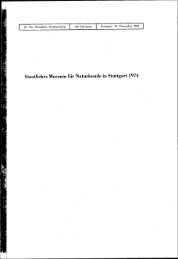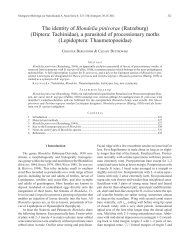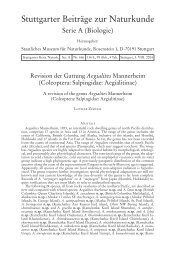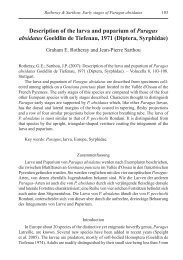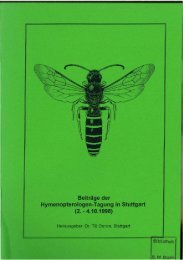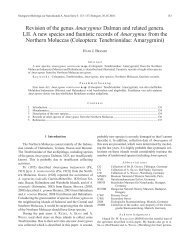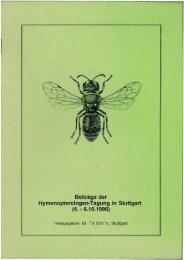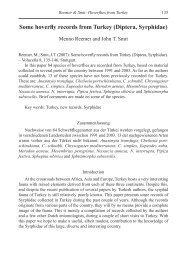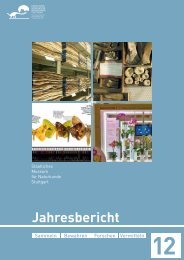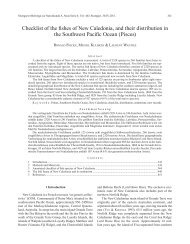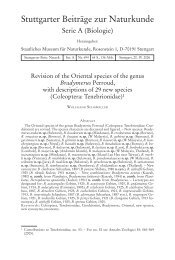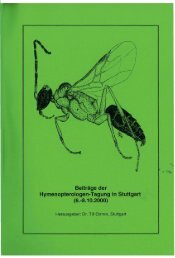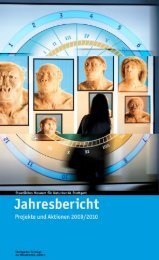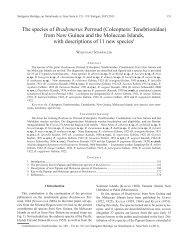Stuttgarter Beiträge zur Naturkunde - Staatliches Museum für ...
Stuttgarter Beiträge zur Naturkunde - Staatliches Museum für ...
Stuttgarter Beiträge zur Naturkunde - Staatliches Museum für ...
You also want an ePaper? Increase the reach of your titles
YUMPU automatically turns print PDFs into web optimized ePapers that Google loves.
<strong>Stuttgarter</strong> <strong>Beiträge</strong> <strong>zur</strong> <strong>Naturkunde</strong><br />
Serie A (Biologie)<br />
Herausgeber:<br />
<strong>Staatliches</strong> <strong>Museum</strong> <strong>für</strong> <strong>Naturkunde</strong>, Rosenstein 1, D-70191 Stuttgart<br />
<strong>Stuttgarter</strong> Beitr. Naturk. Ser. A Nr. 663 12 S., 6 Abb. Stuttgart, 14. VI. 2004<br />
New data on zoogeography and taxonomy<br />
of the African species of the genus<br />
Sivacrypticus Kaszab<br />
(Coleoptera: Archeocrypticidae)<br />
MARTIN LILLIG<br />
Abstract<br />
This paper presents new localities of the African species of the genus Sivacrypticus Kaszab,<br />
1964, considerably extending the known distribution areas of some species. S. tanganyikanus<br />
Kaszab, 1971 is redescribed, and its male genitalia are illustrated for the first time. Distribution<br />
maps are provided for all treated species. Distribution patterns of the African representatives<br />
of the genus are discussed. A checklist of all known species of the genus is provided, including<br />
information about the original description, synonyms and distribution.<br />
Keywords: Coleoptera, Archeocrypticidae, Sivacrypticus, Africa, zoogeography, checklist.<br />
Zusammenfassung<br />
Neue Funde der afrikanischen Arten aus der Gattung Sivacrypticus Kaszab, 1964 werden<br />
vorgestellt. Dadurch erweitert sich das bekannte Verbreitungsgebiet einiger Arten erheblich.<br />
Die Beschreibung von S. tanganyikanus Kaszab, 1971 wird ergänzt und das männliche Genital<br />
dieser Art erstmals abgebildet. Zu allen behandelten Arten wird eine Verbreitungskarte gegeben,<br />
und Verbreitungstypen der afrikanischen Vertreter der Gattung werden diskutiert. In<br />
einem Katalog werden alle bekannten Arten der Gattung mit Angaben <strong>zur</strong> Originalbeschreibung,<br />
zu Synonymen und Verbreitung aufgeführt.<br />
Contents<br />
1 Introduction . . . . . . . . . . . . . . . . . . . . . . . . . . . . . . . . . . . . . . . . . . . . . . . . . . . . . . . . . . . . . 2<br />
2 Methods . . . . . . . . . . . . . . . . . . . . . . . . . . . . . . . . . . . . . . . . . . . . . . . . . . . . . . . . . . . . . . . . . 3<br />
3 African species of Sivacrypticus Kaszab, 1964 . . . . . . . . . . . . . . . . . . . . . . . . . . . . . . . . . . 3<br />
3.1 Sivacrypticus latipes Kaszab, 1979 . . . . . . . . . . . . . . . . . . . . . . . . . . . . . . . . . . . . . . . . 3<br />
3.2 Sivacrypticus enigmaticus Kaszab, 1969 . . . . . . . . . . . . . . . . . . . . . . . . . . . . . . . . . . . 4<br />
3.3 Sivacrypticus szunyoghyi Kaszab, 1971 . . . . . . . . . . . . . . . . . . . . . . . . . . . . . . . . . . . . 5<br />
3.4 Sivacrypticus congoanus Kaszab, 1969 . . . . . . . . . . . . . . . . . . . . . . . . . . . . . . . . . . . . 5<br />
3.5 Sivacrypticus murinus Ardoin, 1969 . . . . . . . . . . . . . . . . . . . . . . . . . . . . . . . . . . . . . . 6<br />
3.6 Sivacrypticus tanganyikanus Kaszab, 1971 . . . . . . . . . . . . . . . . . . . . . . . . . . . . . . . . . 6<br />
3.7 Sivacrypticus ardoini Kaszab, 1969 . . . . . . . . . . . . . . . . . . . . . . . . . . . . . . . . . . . . . . . 9<br />
4 Zoogeography . . . . . . . . . . . . . . . . . . . . . . . . . . . . . . . . . . . . . . . . . . . . . . . . . . . . . . . . . . . . 9<br />
5 Threatened species . . . . . . . . . . . . . . . . . . . . . . . . . . . . . . . . . . . . . . . . . . . . . . . . . . . . . . . . 10
2 stuttgarter beiträge <strong>zur</strong> naturkunde Ser. A, Nr. 663<br />
6 Checklist of the species of Sivacrypticus Kaszab, 1964 . . . . . . . . . . . . . . . . . . . . . . . . . . . 10<br />
7 References . . . . . . . . . . . . . . . . . . . . . . . . . . . . . . . . . . . . . . . . . . . . . . . . . . . . . . . . . . . . . . . 11<br />
1 Introduction<br />
The status of the Archeocrypticini has been controversial for a long time. The<br />
group was first placed as a tribe Archeocrypticini in the proximity of Crypticini<br />
(KASZAB 1964), but its genus Enneboeus Waterhouse, 1878 was placed by GEBIEN<br />
(1938–1942) in the Diaperini. ARDOIN (1969), describing a new species from West<br />
Africa, retained the Archeocrypticini within the Tenebrionidae. WATT (1974: 387)<br />
considered several larval and imaginal characteristics and raised the status of the<br />
tribe Archeocrypticini to the family level as Archeocrypticidae. However KASZAB<br />
(1975, 1979, 1981, 1984) continued to refer to the group as part of the Tenebrionidae<br />
and denied their status as a separate family. Other authors (including ARDOIN 1980,<br />
DOYEN et al. 1989, LAWRENCE 1977, 1994, MASUMOTO & YIN 1993, MATTHEWS<br />
1987, MERKL 1988, TRIPLEHORN & WHEELER 1979) preferred to follow WATT’s<br />
opinion. According to LAWRENCE (1977), the Archeocrypticidae are more closely<br />
related to the Pterogeniidae than to the Tenebrionidae, and also have a close relationship<br />
to the Ciidae, Tetratomidae and Mycetophagidae. LAWRENCE (1994) gave a<br />
detailed description of the larval and imaginal characteristics. An excellent key to the<br />
species of the genus Sivacrypticus has been provided by KASZAB (1979).<br />
The biology of the Archeocrypticidae is largely unknown. The larvae of the genus<br />
Enneboeus Waterhouse are known to live in leaf litter and consume rotting plant<br />
parts (LAWRENCE 1977).<br />
Archeocrypticidae are caught using Tullgren’s and Berlese’s apparatus, occasionally<br />
also with light (MATTHEWS 1987), by sifting of soil litter (SCHAWALLER, personal<br />
communication) or with pitfall traps. Some Australian species have been collected<br />
on fungi of the family Polyporaceae (LAWRENCE 1994).<br />
There are scanty collection reports of the species of the genus so far. The examination<br />
of hitherto unpublished material shows that most species of this genus are<br />
widely distributed over the continent.<br />
Acronyms of repositories<br />
CL Collection MARTIN LILLIG, Saarbrücken, Germany<br />
MHNG Muséum d’Histoire naturelle, Genève, Switzerland<br />
MRAC Musée Royal de l’Afrique Centrale, Tervuren, Belgium<br />
SMNS <strong>Staatliches</strong> <strong>Museum</strong> <strong>für</strong> <strong>Naturkunde</strong>, Stuttgart, Germany<br />
TM Transvaal <strong>Museum</strong>, Pretoria, Republic of South Africa<br />
TMB Természettudományi Muzeum, Budapest, Hungary<br />
ZfB Zentrum <strong>für</strong> Biodokumentation, Landsweiler-Reden, Germany<br />
ZSM Zoologische Staatssammlung, München, Germany<br />
Acknowledgements<br />
For the loan of types and other specimens, I would like to thank Dr. OTTÓ MERKL (Budapest),<br />
Dr. MARTIN BAEHR (Munich), Dr. IVAN LÖBL and Dr. GIULIO CUCCODORO (both<br />
Geneva), Dr. MARC DE MEYER (Tervuren), Dr. HARALD SCHREIBER (Landsweiler-Reden), Dr.<br />
WOLFGANG SCHAWALLER (Stuttgart) and Mrs. RUTH MÜLLER (Pretoria). Thanks are extended<br />
to Prof. Dr. PETER NAGEL (Basel) and Dr. WOLFGANG SCHAWALLER (Stuttgart) for the critical<br />
reading of the manuscript and for valuable comments, and to Dr. RONALD FRICKE<br />
(Stuttgart) for the linguistic revision.
lillig, african sivacrypticus 3<br />
2 Methods<br />
This paper is based on material of several museums and the author’s collection. The specimens<br />
could be examined during the visits at the Zoologische Staatssammlung Munich, the<br />
<strong>Staatliches</strong> <strong>Museum</strong> <strong>für</strong> <strong>Naturkunde</strong> Stuttgart and the Zentrum <strong>für</strong> Biodokumentation,<br />
Landsweiler-Reden. Furthermore the beetles could be studied for many months due to the<br />
kindness of the borrowers.<br />
The label text is quoted from the original labels as they are pinned to the specimens.<br />
3 African species of Sivacrypticus Kaszab, 1964<br />
3.1 Sivacrypticus latipes Kaszab, 1979 (map Fig. 1)<br />
Studied type material: Sudan, Prov. Darfur, El Fasher, 730 m, ad lucem, 2.IX.1976, H.<br />
J. BREMER leg. (1 paratype MRAC, 2 paratypes ZSM).<br />
New records: Elfenbeinküste, Kafolo/Comoé, 25.IV.1988, leg. F.-T. KRELL (5 ex.<br />
SMNS). – Elfenbeinküste, Ferkessédougou, 19.IV.1988, leg. F.-T. KRELL (1 ex. SMNS). – Côte<br />
d’Ivoire, Badénou/M’Bengué, 1982, DISTER, HUSCHENS, SUMMKELLER (1 ex. ZfB). – Ober-<br />
Fig. 1. Distribution of Sivacrpyticus latipes Kaszab (• ).
4 stuttgarter beiträge <strong>zur</strong> naturkunde Ser. A, Nr. 663<br />
volta, 10 km SE Tiefora, Galeriewald am Sinlo, 11.I.–19.II.82, NAGEL, SCHREIBER, KALMUND<br />
(38 ex. ZfB). – Obervolta, 10 km SE Tiefora, Galeriewald am Sinlo, 10.I.–25.II.83, H.<br />
SCHREIBER, M. PAULUS (26 ex. ZfB). – Obervolta, 10.58N 4.50W, 10 km SE Tiefora, Galeriewald<br />
am Sinlo, 18.I.–10.II.84, H. SCHREIBER, M. BIEGEL (6 ex. ZfB). – Obervolta, 10 km<br />
E Dérégoué, Savanne, Bodenfalle, 26.I.–22.II.82, H. SCHREIBER, M. PAULUS (1 ex. ZfB). –<br />
Obervolta, 4 km NE Dérégoué, Galeriewald am Koba, Bodenfalle, 10.I.–25.II.82, H.<br />
SCHREIBER, M. PAULUS (120 ex. ZfB). – Ghana, Bagjamze, 8.I.1969, leg. B. ENTZ (1 ex. TM).<br />
Remarks: Sivacrypticus latipes is widespread throughout the savanna belt from<br />
Guinea to Sudan. It is very abundant in the gallery forests of Burkina Faso and of the<br />
Ivory Coast, where it was collected by means of pitfall traps.<br />
3.2 Sivacrypticus enigmaticus Kaszab, 1969 (map Fig. 2)<br />
Studied type material: Soil-Zoological Exp., Congo-Brazzaville, Kindamba, Méya,<br />
Bangou forest / 31.X.1963, No. 51, sifted litter, leg. ENDRÖDY-YOUNGA (1 paratype ZSM).<br />
Fig. 2. Distribution of Sivacrpyticus enigmaticus Kaszab (• ) and S. szunyoghyi Kaszab ().
lillig, african sivacrypticus 5<br />
3.3 Sivacrypticus szunyoghyi Kaszab, 1971 (map Fig. 2)<br />
New records: Uganda, Mt. Elgon, Sipi, 1750 m, 31.V.1993, CUCCODORO & ERNE # 178<br />
(1 ex. MHNG). – South Africa, RSA, KwaZulu-Natal, Kosi Bay Nature Reserve,<br />
11.–17.VI.2002, leg. W. SCHAWALLER (1 ex. SMNS).<br />
Remarks: This species was described on the basis of two specimens collected at<br />
the Usa River, Tanzania. Hitherto, no further records have been published.<br />
3.4 Sivacrypticus congoanus Kaszab, 1969 (map Fig. 3)<br />
Studied type material: Soil-Zoological Exp., Congo-Brazzaville, Brazzaville,<br />
ORSTOM park / 19.X.1963, No. 10, sifted compost, leg. ENDRÖDY-YOUNGA (holotype<br />
TMB). – 27.XII.1963. No. 533, beaten and singled, leg. BALOGH & ZICSI / Soil-Zoological<br />
Exp., Congo-Brazzaville, Brazzaville, ORSTOM park (1 paratype TMB). – Soil-Zoological<br />
Exp., Congo-Brazzaville, Brazzaville, ORSTOM park / 18.X.1963, No. 3, singled in park,<br />
leg. ENDRÖDY-YOUNGA (1 paratype ZSM).<br />
New record: Ghana, Tafo, I-1968, E. O. BOAFO (1 ex. ZMB).<br />
Fig. 3. Distribution of Sivacrpyticus congoanus Kaszab (• ) and S. murinus Kaszab ().
6 stuttgarter beiträge <strong>zur</strong> naturkunde Ser. A, Nr. 663<br />
Remarks: The holotype was labelled as “Sivacrypticus congoensis” by KASZAB<br />
but published as “Sivacrypticus congoanus” (KASZAB 1969). The specimen from<br />
Ghana well agrees with the three Brazzaville specimens.<br />
3.5 Sivacrypticus murinus Ardoin, 1969 (map Fig. 3)<br />
Studied type material: Bingerville I.1962, J. DECELLE, Ivory Coast / Sivacrypticus<br />
murinus n. sp., P. ARDOIN 1967 (holotype MRAC). – Bingerville IV.1961, XI.1961, I.1962,<br />
II.1962, 1.–12.III.1962, 15.–31.III.1962, IV.1962, IX.1962, XII.1962, I.1963, II.1963,<br />
1.–18.IV.1963, I.1964, II.1964, III.1964, IV.1963, J. DECELLE, Ivory Coast / Sivacrypticus murinus<br />
n. sp., P. ARDOIN 1967 (29 paratypes MRAC). – Ivory Coast, Bingerville X.1962, J. DE-<br />
CELLE (1 paratype TMB).<br />
New records: Elfenbeinküste, Adiopodoumé, 10.IV.1988, leg. F.-T. KRELL (1 ex. SMNS).<br />
– Côte d’Ivoire, Adiopo-Doumé, 29.X.80, MAHNERT-PERRET (1 ex. TMB). – Côte d’Ivoire,<br />
Marahoué Ranch bei Mankono, 15.XI.–15.XII.1981 / W [= Wald, forest] / DISTER, NAGEL,<br />
SUMMKELLER (1 ex. ZfB).<br />
Remarks: ARDOIN (1980) listed samples from Adiopodoumé and the surroundings<br />
of Man and Sassandra, Ivory Coast. – KASZAB (1979) had no males at his disposal.<br />
Since the two samples from Adiopo-Doumé and from the Marahoué Ranch<br />
are females, the males remain unknown. – This species was previously known only<br />
from the coastal area and the surroundings of Man, i. e. the tropical rainforest. The<br />
sample from the Guinean savanna near Mankono originated from a closed half evergreen<br />
rainforest island surrounded by savanna. Also numerous species of butterflies<br />
of the evergreen rainforest islands can be found near the coast (SUMMKELLER, personal<br />
communication).<br />
3.6 Sivacrypticus tanganyikanus Kaszab, 1971 (Figs. 5–6; map Fig. 4)<br />
Studied type material: Tanganyika, Usa River, 3900 feet, Coll. Dr. J. SZUNYOGHY /<br />
light trap, 15.XI.–31.XII.1965 (female holotype and 1 paratype TMB).<br />
New records: Malawi S, Masenjere env. (80 km S of Blantyre), 21.–22.XII.2001, J.<br />
BEZDĚK leg. (11 ex. SMNS, 3 ex. CL). – S Africa, North Prov., KNP, Pafuri, S 22.26 E 31.12,<br />
5.–7.XII.1997, S. BILY´ leg. (28 ex. CL). – S Africa, North Prov., Waterberg; S 24.22 E 27.33,<br />
Geelhoudbosh farm, S. BILY´ leg.; 15.–18.XI.1997 (34 ex. CL). – RSA, KwaZulu-Natal, Kosi<br />
Bay Nature Reserve, 11.–17.XI.2002, leg. W. SCHAWALLER (4 ex. SMNS). – RSA, KwaZulu-<br />
Natal, Tembe Elefant Park, 17.–19.XI.2002, leg. W. SCHAWALLER (2 ex. SMNS, 1 ex. CL). –<br />
S.Afr., Zululand, St. Lucia, Mission Rk., 28.22 S – 32.25 E / 9.XII.1975, E-Y: 965, UV light<br />
collection, leg. ENDRÖDY-YOUNGA (1 ex. TM). – S.Afr., E.Transvaal, Barberton, 10 km N,<br />
25.44 S – 30.59 E / 24.X.1986, E-Y: 2308, groundtraps, 31 days, leg. ENDRÖDY-YOUNGA /<br />
ground traps with meat bait (1 ex. TM). – S.Afr., Natal, Charters Creek / 21.I.1990, leg. J. KLI-<br />
MASZEWSKI (1 ex. TM). – S.Afr., KrugerNat.Pk, Skukuza-Sabi River, 24.57 S – 31.42 E /<br />
22.II.1995, E-Y: 3111, riverinefor. litter, leg. ENDRÖDY-YOUNGA (12 ex. TM). – S.Afr.,<br />
KrugerNat.Pk, Pafuri research, ca 22.25 S – 31.12 E / 26.I.1995, E-Y: 3100, UV light & trap,<br />
leg. C. L. BELLAMY (23 ex. TM). – S.Afr., Zulu coast, Sodwana Bay, 27.35 S – 32.39 E /<br />
23.XI.1992, E-Y: 2848, UV light. N of camp, leg. ENDRÖDY-YOUNGA (23 ex. TM). – S.Afr., N<br />
Zululand, Nduma Game Reserve, 26.54 S – 32.17 E / 1.XII.1992, E-Y: 2868, groundtraps, 5<br />
days, leg. ENDRÖDY-YOUNGA / groundtrap with faece bait (1 ex. TM). – S.Afr., N Zululand,<br />
Nduma Game Reserve, 26.54 S – 32.16 E / 12.VI.1989, E-Y: 2614, gallery forest litter / EN-<br />
DRÖDY & KLIMASZEW. (3 ex. TM). – S.Afr., Mapumalanga, Hazyview, 25.04 S – 31.07 E /<br />
27.I.1996, E-Y: 3207, sift. forest litter, leg. ENDRÖDY-YOUNGA (2 ex. TM). – S.Afr., N<br />
Province, Mapaphuli Cyas Res, 24.48 S – 30.37 E / 28.I.1998, E-Y: 3319, sifting, leg. R.<br />
MÜLLER (2 ex. TM). – S.Afr., Mozambique, Pomene, 22.59 S – 35.35 E / 4.V.1974, E-Y: 355,<br />
litt. in coast humm., leg. A. STRYDOM (2 ex. TM). – 10.X.1975, groundtraps 29, leg. RUSSELL-<br />
SMITH / Botswana, Okavango, Makwee lagoon (1 ex. TM). – Karskul, S. Angola, IX.1951, C.<br />
KOCH (1 ex. TM).
lillig, african sivacrypticus 7<br />
Fig. 4. Distribution of Sivacrpyticus tanganyikanus Kaszab (• ) and S. ardoini Kaszab ().<br />
Remarks: The specimens from Malawi, Mozambique, South Africa, Botswana<br />
and Angola do not show any external characteristics that can be used to differentiate<br />
them from the Tanzania females. All records are therefore regarded as conspecific.<br />
East African males are needed to prove the identity. The large series from southern<br />
Africa including numerous males allows an extension of the description by KASZAB:<br />
Size: Length 2.1–2.8 mm. Width 1.1–1.5 mm.<br />
Colour: Light to dark brown; body edges and posterior border of the pronotum<br />
somewhat lighter, appendages reddish. Surface appears dull due to dense shagreened<br />
sculpture. Setae grey-yellowish, labrum lighter and clypeus dark coloured<br />
Setae: Upper and lower body parts covered with very thin, but closely set setae.<br />
Setae depressed, orientated backwards.<br />
Body shape: Ovoid, largest width at the shoulders.<br />
Head: Transversally vaulted. Densely punctate. Labrum transversal, covered with<br />
setae. Clypeus frontally straight, clypeal suture complete. Genae short. Eyes coarse
8 stuttgarter beiträge <strong>zur</strong> naturkunde Ser. A, Nr. 663<br />
ly faceted, distance between the eyes, as seen from above, about 4.5 times broader<br />
than the eye width. Antennal club composed of 3 flattened terminal segments.<br />
Prothorax: Convex, almost as wide as long. Prothorax densely, but somewhat<br />
more finely punctate than the head. Anterior border almost straight, anterior corners<br />
somewhat protuberant. Lateral edges curved, narrower anteriorly than posteriorly.<br />
Base almost weakly double bulged. Lateral margination slightly narrows towards<br />
the posterior part. Anterior and posterior edges unbordered.<br />
Scutellum: Small, flat, almost semicircular, very finely and densely punctate.<br />
Alae: Posterior wings fully developed.<br />
Elytra: Convex. Ratio length to width about 10 : 8. Base of elytra as wide as base<br />
of pronotum. Maximum width at the shoulders, rounder and narrower towards<br />
apex. Punctation much more pronounced here than on the pronotum, frontally irregular,<br />
laterally and backwards forming regular rows. Punctation smoother towards<br />
the apex. Scutellar interspace, 3 rd , 5 th and 7 th intervals without punctation and<br />
slightly vaulted.<br />
Prosternum: Prosternal apophysis flat, not depressed and projecting far behind<br />
the fore coxae, apically regularly widened, apex rounded.<br />
Mesosternum: Very short. Punctate.<br />
Figs. 5–6. Sivacrypticus tanganyikanus Kaszab. 1. Aedeagus, dorsal view. 2. Aedeagus, lateral<br />
view. – Scale: 1 mm.
lillig, african sivacrypticus 9<br />
Metasternum: Punctate in a more extensive, but also more pronounced fashion<br />
than on mesosternum.<br />
Sternite: Punctation scarcely visible. Last abdominal sternite almost without an<br />
excision in males and with a flat one only in females.<br />
Legs: Flattened. Protibiae widened. Tarsal formula 5-5-4, 1 st segment of the<br />
metatarsi as long as the others together. In males, pro- and mesotarsi widened.<br />
Aedeagus: See Figs. 5–6.<br />
Diagnosis: Pro- and mesotarsi widened in males, laterally and apically pronounced<br />
rows of punctations on elytra. Sutural row apically not deepened. – This<br />
species differs from S. ardoini Kaszab in the absence of an apically deepened row of<br />
punctures on the elytra and differs from all other African species in the presence of<br />
a pronounced punctation on the elytra.<br />
3.7 Sivacrypticus ardoini Kaszab, 1969 (map Fig. 4)<br />
Studied type material: Soil-Zoological Exp., Congo-Brazzaville, Brazzaville,<br />
ORSTOM park / 17.XI.1963, light trap, leg. ENDRÖDY-YOUNGA (3 paratypes TMB,<br />
1 paratype ZSM); same data, but 19.XI.1963 (1 paratype TMB); same data, but 20.XI.1963<br />
(2 paratypes TMB). – Soil-Zoological Exp., Congo-Brazzaville, Djoue river / 25.X.1963,<br />
No. 28, sifted litter, leg. ENDRÖDY-YOUNGA (1 paratype ZSM). – Soil-Zoological Exp., Congo-Brazzaville,<br />
Sibiti IRHO, rainforest / 25.XI.1963, netted on forestborder, leg. ENDRÖDY-<br />
YOUNGA (1 paratype ZSM).<br />
New records: Angola, 16901 / Sivacrypticus sp., det. KASZAB (2 ex. TMB). – Angola, riv.<br />
Tchikapa, 50 km. S. de Dundo, Ang. 913.1 – VII-1948, A. DE BARROS MACHADO (1 ex. ZSM).<br />
Remarks: The species was hitherto known only from Congo-Brazzaville and<br />
Ghana (KASZAB 1981). KASZAB (1979) reports a length between 2.3 and 2.6 mm. One<br />
of the TMB specimens from Angola “16901” is markedly smaller with a length of<br />
2.15 mm.<br />
4 Zoogeography<br />
The family Archeocrypticidae is consisting of 50 species in 10 genera. They are<br />
distributed in South and Central America, the southern parts of North America,<br />
Africa south of the Sahara, the Indian subcontinent, southern China, and Australia.<br />
This distribution pattern suggests that the family is a classical Gondwana element.<br />
Fourteen species of the genus Sivacrypticus live in the Oriental Realm, eight in the<br />
Ethiopian and one in the Australian Realm, the latter probably having been introduced<br />
from Asia (LAWRENCE 1994). Except for the New World, the genus Sivacrypticus<br />
is to be found all over the distribution range of this family. In Africa, the genus<br />
Sivacrypticus is the only representative of the family. On the basis of the new findings,<br />
three distribution patterns of African Sivacrypticus can be distinguished:<br />
Transsahelian distribution<br />
(S. latipes)<br />
Numerous insect species are distributed all over the Sahel region: for example, the<br />
Paussinae (Carabidae) species Paussus laevifrons (Westwood, 1833) or the Tenebrionidae<br />
Zophosis posticalis Deyrolle, 1867 and Adesmia antiqua (Klug, 1830). These<br />
are xerophilous species which nevertheless avoid the adjacent desert in the north. In<br />
the south, the distribution area is limited by the hylaea. Unlike the above mentioned
10 stuttgarter beiträge <strong>zur</strong> naturkunde Ser. A, Nr. 663<br />
species Sivacrypticus latipes prefers more humid places within the savanna belt. It<br />
does not colonise the open savanna, but is restricted to gallery forests, similar to<br />
Paussus pilosus Reichensperger, 1957.<br />
West African distribution<br />
(S. enigmaticus, S. congoanus, S. murinus, S. ardoini)<br />
These species live in tropical rainforests. Occasionally, they also penetrate into the<br />
savanna along the gallery forests. They use the microclimatic conditions of the particular<br />
sites. No Archeocrypticidae have been reported yet from the Central African<br />
hylaea. Whether or not this is due to a lack of knowledge cannot be judged at present.<br />
Distribution in eastern and southern Africa<br />
(S. szunyoghyi, S. tanganyikanus)<br />
Two species are distributed from eastern Africa to southern Africa, one extending<br />
its area to the south of the rainforests up to the south-west of Angola. These species<br />
apparently avoid the dry regions.<br />
5 Threatened species<br />
All African species of the genus live in rainforests, coastal forests, gallery forests<br />
or forest islands. Their occurrence therefore directly depends on the conservation of<br />
these forests. During the last 35 years gallery forests in Central Africa have spread<br />
into the adjacent savannas. One important reason is the increased rural depopulation<br />
and, connected to it, the reduction of the stress caused by the breeding of cattle and<br />
bushfire. Multitemporal mapping of northern Congo indicates for the northern<br />
Guinea-Sudan region a future natural regeneration and expansion of the arborescent<br />
vegetation (RUNGE 2003). Consequently, the distribution area of the rainforest fauna<br />
in the northern part of the distribution area of Sivacrypticus will possibly expand.<br />
6 Checklist of the species of Sivacrypticus Kaszab, 1964<br />
Sivacrypticus Kaszab, 1964 (KASZAB 1964: 384). Type species: S. taiwanicus Kaszab, 1964 by<br />
original designation.<br />
S. sericans (Fairmaire, 1896) (FAIRMAIRE 1896: 24); India.<br />
Platydema sericans Fairmaire, 1896 (FAIRMAIRE 1896: 24). Type locality: India, Belgaum.<br />
Microcrypticus sericans Gebien, 1939 comb. nov. (GEBIEN 1939 (1938–1942): 748).<br />
Enneboeus spinifer Champion, 1920 (CHAMPION 1920: 73). Type locality: India, Sarda in<br />
Bengal.<br />
S. malabaricus (Champion, 1920) (CHAMPION 1920: 73); India.<br />
Enneboeus malabaricus Champion, 1920 (CHAMPION 1920: 73). Type locality: S India,<br />
Malabar.<br />
S. taiwanicus Kaszab, 1964 (KASZAB 1964: 385); Sri Lanka. Type locality: Formosa, Pilam.<br />
S. taivanicus Kaszab, 1975 (KASZAB 1975: 31); lapsus calami.<br />
S. indicus Kaszab, 1964 (KASZAB 1964: 386); Pakistan, India, Nepal, Sri Lanka. Type locality:<br />
S India, Ramandorog.<br />
S. ardoini Kaszab, 1969 (KASZAB 1969: 239); Congo-Brazzaville, Ghana, Angola. Type locality:<br />
Congo-Brazzaville, Brazzaville (ORSTOM park).<br />
S. congoanus Kaszab, 1969 (KASZAB 1969: 240); Congo-Brazzaville, Ghana. Type locality:<br />
Congo-Brazzaville, Brazzaville (ORSTOM park).
lillig, african sivacrypticus 11<br />
S. enigmaticus Kaszab, 1969 (KASZAB 1969: 241); Congo-Brazzaville. Type locality: Congo-<br />
Brazzaville, Kindamba, Méya, Bangou Forest.<br />
S. murinus Ardoin, 1969 (ARDOIN 1969: 202); Ivory Coast. Type locality: Ivory Coast,<br />
Bingerville.<br />
S. tanganyikanus Kaszab, 1971 (KASZAB 1971: 235); Tanzania, Malawi, Mozambique, South<br />
Africa, Botswana, Angola. Type locality: Tanzania, Usa River.<br />
S. szunyoghyi Kaszab, 1971 (KASZAB 1971: 235); Uganda, Tanzania, South Africa. Type locality:<br />
Tanzania, Usa River.<br />
S. kashmirensis Kaszab, 1975 (KASZAB 1975: 34); India: Kashmir. Type locality: N India, Kashmir,<br />
Zabarwon Hill, Pari Mahal.<br />
S. bengalicus Kaszab, 1975 (KASZAB 1975: 34); India: Darjeeling, Assam. Type locality: N India,<br />
Darjeeling, below North Point.<br />
S. latipes Kaszab, 1979 (KASZAB 1979: 191); Guinea, Burkina Faso, Ivory Coast, Ghana, Sudan.<br />
Type locality: N Ghana, Tamale.<br />
S. loebli Kaszab, 1979 (KASZAB 1979: 196); India, Sri Lanka. Type locality: S India, Madras,<br />
Alagarkovil, 21 km N Madurai.<br />
S. vietnamensis Kaszab, 1979 (KASZAB 1979: 198); Vietnam. Type locality: N Vietnam, Mai<br />
lam, NE Hanoi.<br />
S. dilliensis Kaszab, 1979 (KASZAB 1979: 200); India: Punjab. Type locality: N India, Punjab,<br />
Dilli, Timor.<br />
S. communis Kaszab, 1979 (KASZAB 1979: 202); India. Type locality: S India, Madras, Cardamon<br />
H., 6 km NE Kumily near Periyar Power.<br />
S. besucheti Kaszab, 1979 (KASZAB 1979: 203); India. Type locality: S India, Kerala, Nelliampathi<br />
Hills, Kaikalty.<br />
S. bremeri Kaszab, 1981 (KASZAB 1981: 111); Thailand. Type locality: NE Thailand, Khon<br />
Kaen.<br />
S. greensladei Kaszab, 1984 (KASZAB 1984: 154); southern Australia. Type locality: S Australia,<br />
Lake Fox edge.<br />
S. philippinus Merkl, 1988 (MERKL 1988: 71); Philippines. Type locality: Philippines, Manila.<br />
S. uenoi Masumoto & Yin, 1993 (MASUMOTO & YIN 1993: 241); China: Yunnan. Type locality:<br />
S China, Yunnan, Menglun, Xishuangbanna.<br />
7 References<br />
ARDOIN, P. (1969): Contribution à la connaissance de la faune entomologique de la Côte-d’<br />
Ivoire (J. DECELLE, 1961–1964). – Annales du Musée Royal d’Afrique Centrale, in – 8°,<br />
Zoologie 175: 139–285, pls. I–XI.<br />
ARDOIN, P. (1980): Tenebrionidae (Coleoptera) récoltés en Côte d’Ivoire par Monsieur I.<br />
LÖBL pendant son expédition, en mars 1977. – Revue suisse de Zoologie 87 (1): 81–90.<br />
CHAMPION, G. C. (1920): Some Indian Coleoptera (2). – The Entomologist’s monthly Magazine<br />
56: 68–77.<br />
DOYEN, J. T., MATTHEWS, E. G. & LAWRENCE, J. F. (1989): Classification and annotated<br />
checklist of the Australian genera of Tenebrionidae (Coleoptera). – Invertebrate Taxonomy<br />
3: 229–260.<br />
FAIRMAIRE, L. (1896): Hétéromères de l’Inde recueillis par M. ANDREWES. – Annales de la Société<br />
entomologique de Belgique 40: 6–62.<br />
GEBIEN, H. (1938–1942): Katalog der Tenebrioniden. Teil II. – Mitteilungen der Münchner<br />
entomologischen Gesellschaft 28 (1938): 49–80, 283–314, 397–428; 29 (1939): 443–474,<br />
739–770; 30 (1940): 405–436, 755–786, 1061–1092; 31 (1941): 331–362, 803–834,<br />
1131–1146; 32 (1942): 308–346.<br />
KASZAB, Z. (1964): The zoological results of GY. TOPÁL’s collectings in South Argentina. 13.<br />
Coleoptera – Tenebrionidae. – Annales historico-naturales Musei nationalis hungarici,<br />
Pars zoologica 56: 353–387.<br />
KASZAB, Z. (1969): The scientific zoological results of the Hungarian soil zoological expedition<br />
to the Brazzaville-Congo. 37. Coleoptera: Tenebrionidae. – Annales historico-naturales<br />
Musei nationalis hungarici, Pars zoologica 61: 225–265.<br />
KASZAB, Z. (1971): The scientific results of Hungarian zoological expedition to Tanganyika.<br />
15. Coleoptera: Tenebrionidae. – Annales historico-naturales Musei nationalis hungarici<br />
63: 225–238.
12 stuttgarter beiträge <strong>zur</strong> naturkunde Ser. A, Nr. 663<br />
KASZAB, Z. (1975): Tenebrioniden aus Indien (Coleoptera). – Acta zoologica Academia scientiarum<br />
hungaricae 21 (1–2): 1–38.<br />
KASZAB, Z. (1979): Die Arten der Gattung Sivacrypticus Kaszab, 1964 (Coleoptera, Tenebrionidae).<br />
– Annales historico-naturales Musei nationalis hungarici 71: 185–204.<br />
KASZAB, Z. (1981): Die Gattungen und Arten der Tribus Archeocrypticini (Coleoptera: Tenebrionidae).<br />
– Folia entomologica hungarica 42 [34] (1): 95–115.<br />
KASZAB, Z. (1984): Revision der australischen Archeocrypticinen (Coleoptera, Tenebrionidae).<br />
– Annales historico-naturales Musei nationalis hungarici 76: 143–163.<br />
LAWRENCE, J. F. (1977): The family Pterogeniidae, with notes on the phylogeny of the Heteromera.<br />
– The Coleopterists Bulletin 31 (1): 25–56.<br />
LAWRENCE, J. F. (1994): Review of the Australian Archeocrypticidae (Coleoptera), with descriptions<br />
of a new genus and four new species. – Invertebrate Taxonomy 8 (2):<br />
449–470.<br />
MASUMOTO, K. & YIN, W. (1993): Two new Yunnanese beetles of the genera Laena (Tenebrionidae)<br />
and Sivacrypticus (Archeocrypticidae) (Coleoptera). – Elytra 21 (2):<br />
239–243.<br />
MATTHEWS, E. G. (1987): A guide to the genera of beetles of South Australia. Part 5 Polyphaga:<br />
Tenebrionoidea. – Special educational Bulletin Series (South Australian <strong>Museum</strong>) 8:<br />
1–67.<br />
MERKL, O. (1988): Novelties of Sivacrypticus Kaszab, 1964 and Enneboeus Waterhouse, 1878<br />
(Coleoptera, Archeocrypticidae). – Annales historico-naturales Musei nationalis hungarici<br />
80: 71–78.<br />
RUNGE, J. (2003): Rezente und vorzeitliche Landschaftsdynamik der Regenwald-Savannen-<br />
Grenze in Zentralafrika. – Geoöko 24: 137–152.<br />
TRIPLEHORN, C. A. & WHEELER, Q. D. (1979): Systematic placement and distribution of Uloporus<br />
ovalis Casey (Coleoptera: Heteromera: Archeocrypticidae). – The Coleopterists<br />
Bulletin 33 (2): 245–250.<br />
WATT, J. C. (1974): A revised subfamily classification of Tenebrionidae (Coleoptera). – New<br />
Zealand Journal of Zoology 1 (4): 381–452.<br />
Author’s address:<br />
Dipl.-Geogr. MARTIN LILLIG, Krämersweg 55, 66123 Saarbrücken, Germany;<br />
e-mail: martin.lillig@t-online.de<br />
Manuscript received: 3.XII.2003, accepted: 3.III.2004.<br />
ISSN 0341-0145<br />
Autoren-Richtlinien: http://www.naturkundemuseum-bw.de/stuttgart/schriften<br />
Schriftleitung: Dr. Hans-Peter Tschorsnig, Rosenstein 1, 70191 Stuttgart<br />
Gesamtherstellung: Gulde-Druck GmbH, 72072 Tübingen



